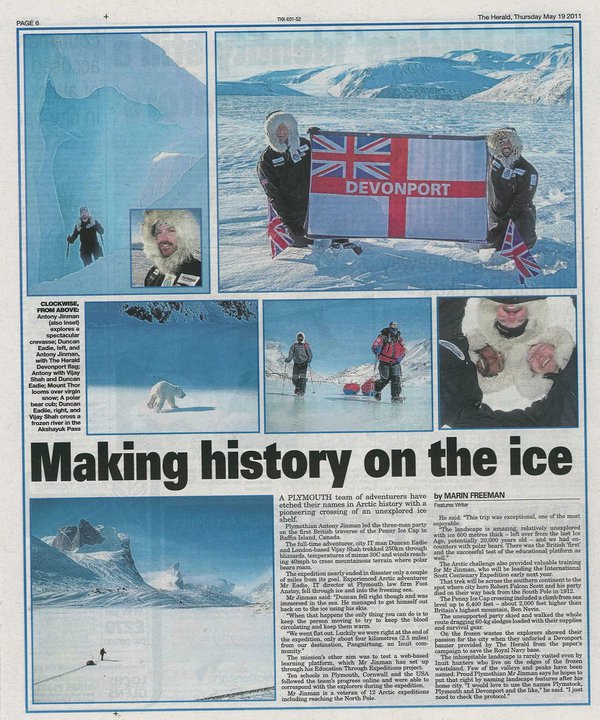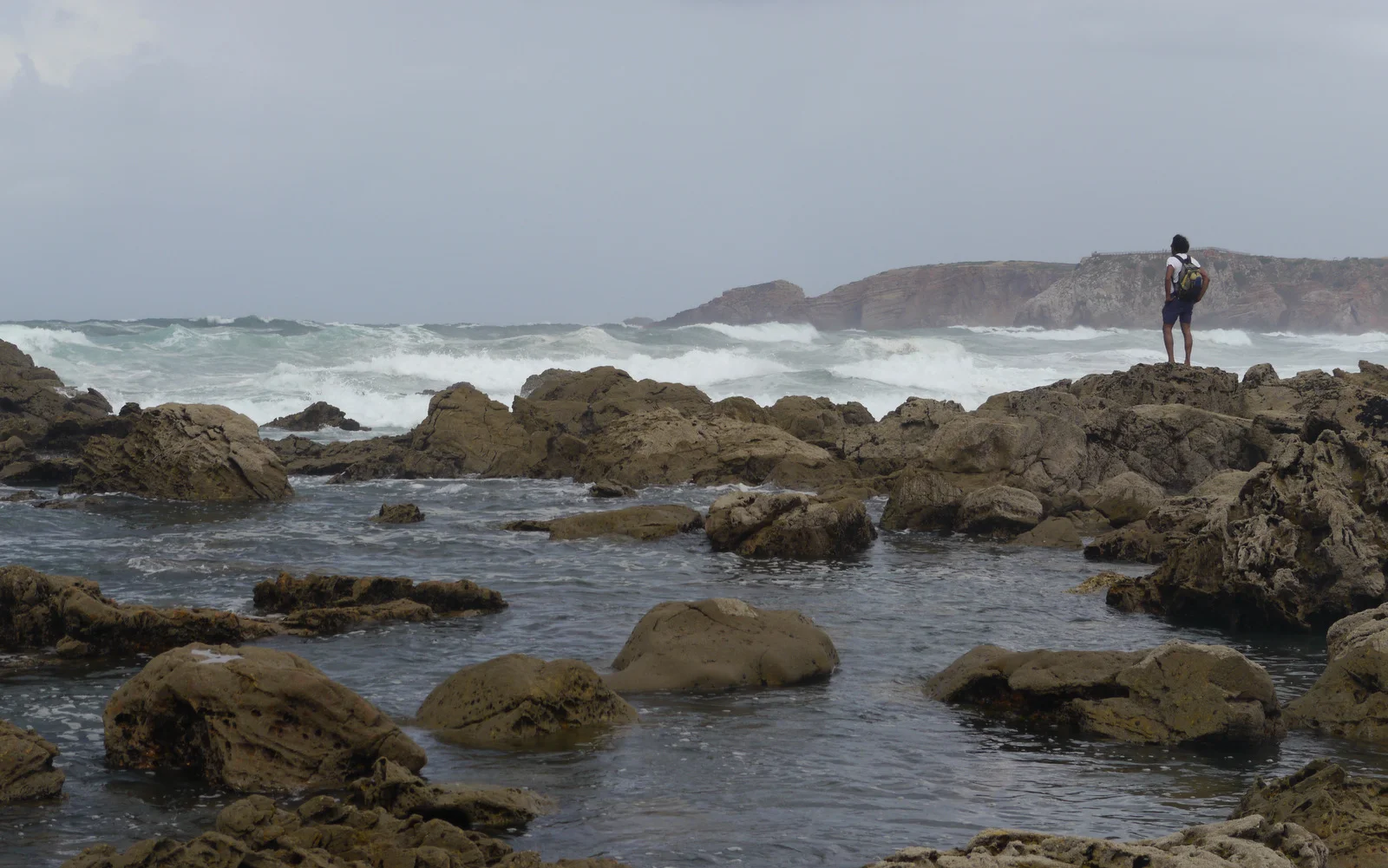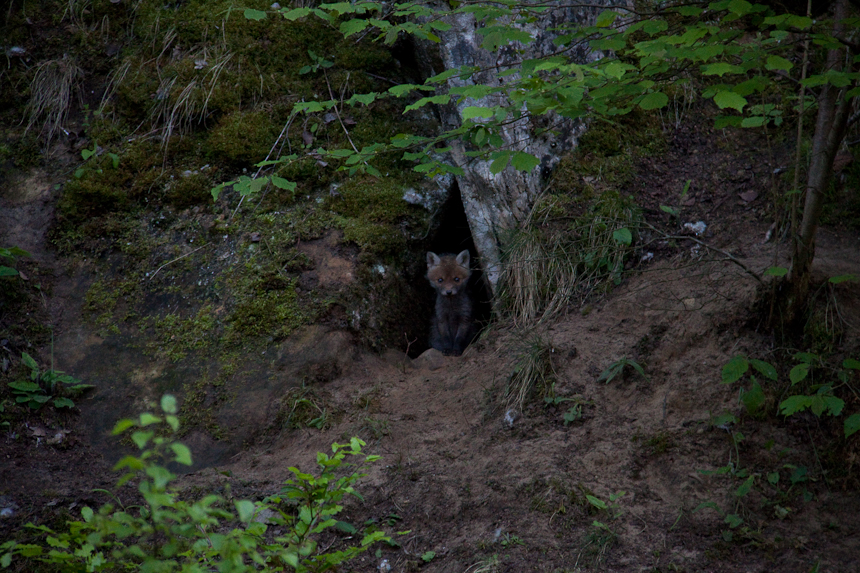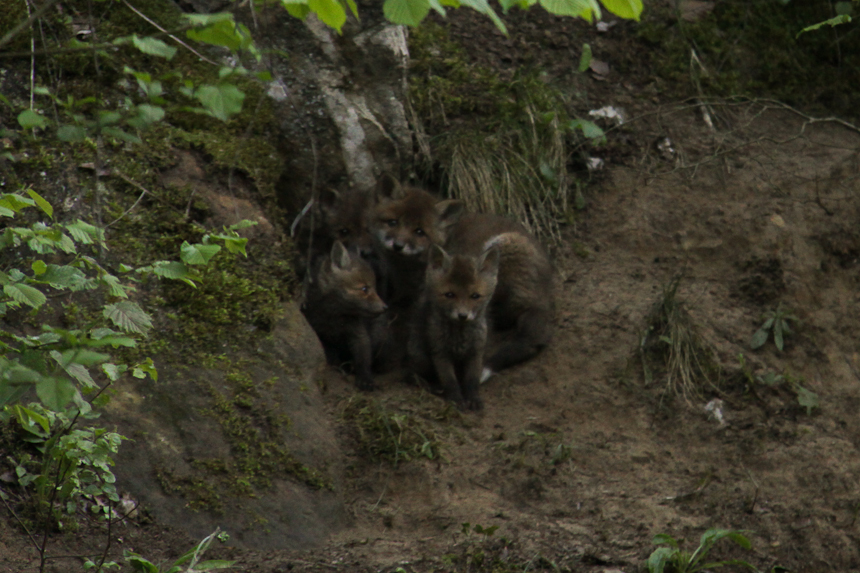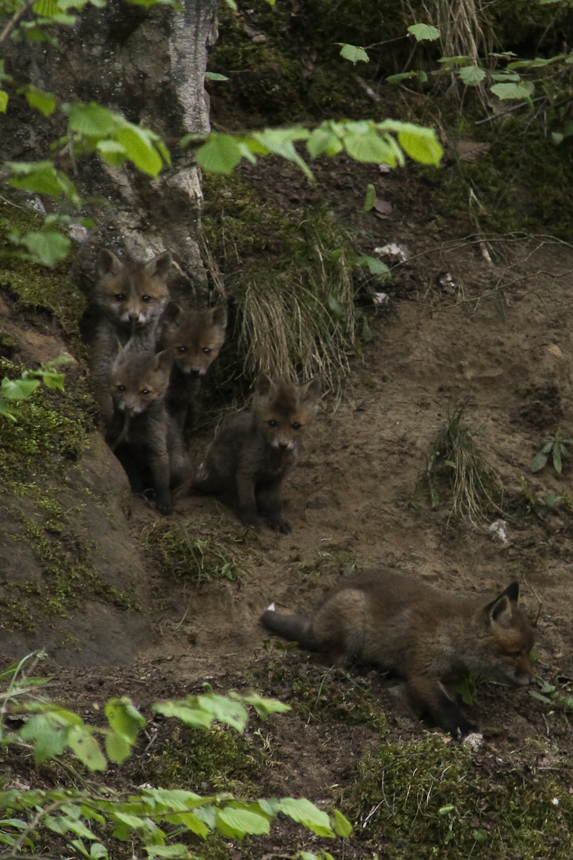A lecture on plate tectonics - Likoma Island, Malawi
Volunteering in Africa
The basis of volunteer work is to do work that requires to be done for the benefit of society or the environment without any financial recompense. It is a socialist concept and one that isn’t tremendously popular in our predominantly capitalist society. Whilst living in north-eastern France for the last three and a half years, I discovered that the concept of volunteering is at the heart of their society. I too participated and was a member of a particular group that organised music festivals and cultural events in the local area. There was no financial reward and if you were to break it completely down we were typically out of pocket due to travel expenses and such. But the sense of achievement and fun we had typically made up for losing our weekends and evenings to long hard days of cooking food, pulling beer and being on our feet for 15 hours at a time. But this article isn’t about the wonders of volunteering in France but what we were astounded by when we went to Southern Africa this year. My girlfriend and I have just returned from a three-month trip in Southern Africa. We hitch-hiked from Namibia to Zimbabwe and continued through Zambia into Malawi. Our journey covered thousands of kilometres, meeting hundreds of people along the way. The cultures and languages within countries and across borders are fascinating and vary to a greater extent than those between neighbouring European states.
What we found in southern Africa was that ‘volunteering’ is a massive industry. But the definition of volunteering is different. What we discovered was that the premise of most ‘volunteer’ projects is that the locals are incapable of developing themselves because they are inherently incapable or culturally inept in making the necessary changes. This premise has to be true in order to justify, say, an eighteen year old, with no previous experience of development work nor knowledge of African culture or history to start telling communities what to do in teaching or health or construction or whatever projects he might be involved in. It is quite simply absurd to think that untrained westerners have a better idea of how people from a different continent, culture, lifestyle, climate should live their lives than they do, or what is best for them in terms of development. Even the experts are continually getting it wrong.
I have seen ‘volunteer’ projects advertised for teaching assistants, sport teachers, medical projects, helping to build a school/hospital or helping to look after animals. Expertise required to join these projects? None. The volunteer does not have to be an expert in his field. The teachers do not have to have any previous teaching experience, the medical helpers no medical or nursing experience and the one helping to look after animals, no zoo-keeping experience or zoology knowledge.
These projects are funded by the volunteer who makes a payment of between hundreds to thousands of pounds to attend a project of duration of typically two weeks to two months. I find that a simple way of determining who is the real beneficiary is by following the money. Whoever is paying is the ultimate beneficiary.
The volunteer benefits from learning about a new culture, experiencing a different lifestyle or close interaction with children or animals. In comparison, the communities that the volunteer has come to help in put up with the westerners with bemusement and with the infinite politeness that is common in these parts.
One day, we inadvertently overheard a conversation between a volunteer agency and leaders of the local community. The volunteer agency stated that they had X number of volunteers arriving soon who want to be involved in teaching sports. They asked the local community leaders whether they could accommodate this. It seems that the ‘need’ for volunteers has not come from the community but rather it is suggested to them from savvy volunteer tour agencies. The link between supply and demand has been lost somewhere in the world of business.
I believe it is important to think about what sort of volunteers are required for a particular need. Wouldn’t, for example, asking a group of professional teachers to lead a course to train local teachers who will stay in the community their whole lives be more beneficial for the long-term development of a school?
Nevertheless I must finish by saying that most of the volunteering programmes are not inherently bad. From my point of view they are tourism trips and should be labelled as such. They are rewarding to the participant and if managed properly the projects may benefit the local community. However they can be detrimental to development when communities stop doing things for themselves: We came across one village chief who mistook us for volunteers. After greeting us he declared that it is good that we are there and that he is relying on us to develop their country for them.
Malawian Sachet Culture
The sachet, as it is popularly known, is a small transparent plastic packet containing about 60ml of cheap, hard liquor. They are available in all the popular brands of alcohol common in these parts as well as other sachet only varieties with fancy names and colourful packaging. They cost as little as 15 kwachas (five pence) each and are typically bought in packs of five or ten. It has become the drink of choice for the poor, young, uneducated or vulnerable. Such is their negative effect on society that Zambia has recently created a country-wide ban on the sachet industry. Just three months after the ban came into force, when we passed through Zambia we didn’t come across their existence. However when we passed across the border into Malawi, the sachet culture slapped us in the face. We first come across the discarded empty sachets littering the dirt road and countryside. They are everywhere and littering the towns, countryside, beaches and forests. The litter problem, typically a Western defined problem (Malawians don’t share the same values on litter) is not the main problem of the sachet-culture, the effect on certain social groups is debilitating. More than once we were harassed by men, madly drunk, incoherent and dangerous.
The affordability and availability of this cheap and potent alcohol means that life even in the most idyllic and rural settlements is being severely affected. Men, who are typically the main consumers, are drunk before midday. Teachers and parents are complaining of the effect on teenage boys who are dropping out of schools to drink sachets. Even children under the age of ten are known to be drinking the substance. Others complain of a rise in domestic and sexual violence. The sachet culture also affects those not directly connected; the transport system based around private mini-buses are becoming increasingly more dangerous as drivers keep themselves awake with the use of sachets.
For a country with a high unemployment rate, such an increase in unproductiveness of the population paralyses development.
Malawi has tried banning the product but a labyrinth of free business, vested interests and long legal processes means that the government required great political will to pass a ban. They do not (yet) have the will. A small success has been had from the Malawian government as they have increased the taxes on alcohol to 250% in the latest budget with the idea to price out school children from the market and make it uneconomical for others. Sadly it still remains too cheap and the sachet problem will not be solved until a total ban is enforced.
Further articles: http://www.nyasatimes.com/malawi/2012/11/04/malawis-chanco-student-dies-after-consuming-alcohol-sachets/
http://www.nyasatimes.com/malawi/2012/07/01/chiefs-back-ban-of-alcohol-sachet/
http://mwnation.com/opinion-and-analysis/weekend-investigates/6767-should-malawi-ban-sachets
http://www.faceofmalawi.com/2012/09/zambia-bans-liquor-sachets/

The village of Chona (no electricity, no running water) PRESENTS: A special lecture on Aeronautics
The village of Chona, Zambia is not really a village at all but more of a focal point, a place of infrastructure where the wider community gathers. It has a health clinic, a school, a small market and a well meaning everyday the community for miles around descend to Chona before heading back to their small plots of land and huts in the evening. It is here at the local school, with so many pupils that the school starts at 7am to 5pm working in two shifts, where I offered to give a lecture on Aeronautics to the eldest math and physics class. The small classroom, packed with fifty Grade 9 pupils wait patiently as I am presented. As with the impeccable politeness of all Zambians they stand when I enter the class room, greeting me formally yet warmly. I forgot to ask them to sit and they continued standing until the head teacher intervened and gave the instruction.
As with schools in the UK, all the pupils wore a school uniform, shirt and tie for boys and skirt, blouse and jumper (?) for the girls. At this age in school, their shirts were not torn or over used and almost all had a note book to write in.
I started at the beginning. The most that any of these children had ever gotten to an aircraft is seeing the large airliners silently cruising through the blue skies kilometers above them. Had they ever asked themselves about how it could fly? Or even how big these aircraft were? From their astonishment I would say no. Their initial shyness, coupled with ignorance soon gave way to intrigue and fascination. Aircraft, aeroplanes, helicopters are understandable to small villagers like themselves who may have never even been in a car before.
They started answering the questions I posed them. One boy, even answered correctly as to why the aircraft needed a tail using his knowledge of the large African birds around them. Another correctly answered to what would happen if the aircraft started to go too slowly. Their questions too became more sophisticated, 'Sir, how do you get oxygen into the aircraft?', 'Why can't you open the windows?'
The greatest part of the lesson was taken up by practical maths. They were to work out in relation to other modes of transport how fast an aircraft travels at. Speed is not something they are accustomed to. The question 'How fast can you travel by bike?' Was met with shrugs until they could think about how far their house was and how long it took to get to school. 30 minutes to travel 7km equals 14km/h. The car, which most had never travelled on, was worked out to be at 120km/h. But how do you work out the speed of an airliner?
I gave them a few clues: 1) Airliners cruise at roughly Mach 0.9, 2) Speed of sound is roughly 300m/s. A few brave children, came to the black board to work it out. Having no calculators all calculation must be done long hand or mentally. When they worked out the speed at 972km/h they were astonished! Shouts of surprise and murmurs of disbelief filled the classroom and exploded to a raucous when they found out that fighter jets can travel at 2-3 times that speed.
Hands were shooting up now and the questions flowed one after another non-stop. But time was now over and I left them in a state of wonder.
As Mr. Moses, the senior teacher, said as we left, "Thank you. It is inspiring to the young village children to realise where they can emerge with studying and the usefulness of it."
[gallery]
ETOSHA - Wildlife Safari
Check out a few of our animal photos from Etosha National Park. Enjoy and welcome to our world! :)
[gallery]
Sand Dunes of Namibia
When you walk or drive through a desert, you might get the impression, that there's no life around you... In case of the Namib, a coastal desert in southern Africa, this assumption is completely wrong. Having endured arid or semi-arid conditions for roughly 55–80 million years, the Namib is the oldest desert in the world. This is one of the reasons why a number of unusual species of plants and animals are found in this desert. Many of them are endemic and highly adapted to the specific climate of the area.
In Swakopmund we had the pleasure to track some of these amazing creatures. Have a look!
[gallery]
The Desert Horses
The Fish River Canyon is the second largest canyon in the world, second only to the Grand Canyon in the USA. We were lucky enough to walk a certain part of it, a 90km section over five days. The Fish River winds itself through a semi-desert landscape deep inside the canyon walls. The hike which follows it's winding path became pathetically slow in places as we negotiated sand dunes and boulder fields. Cheekily, we spent a lot of time looking for the trail of other (guided) groups that may have picked a more direct line or found firmer sand to walk on. Most of the time we didn’t find it – if there was one at all! :-)
But every time we saw some horse shit on the ground we said to each other: "We must be right here. Only locals or guides with groups would hike the Fish River Canyon with horses" – and we nonchalantly followed the signs.
One late afternoon, when we were ready to make camp, we spotted two horses on the other side of the river. They were beautiful in the warm evening light of the sunset and turned their heads towards us watching us attentively. We were happy to see that they were free and could move up and down the river as they wished, finding the juiciest plants to munch on. Yet we asked ourselves where the owner might be as we couldn’t hear or see anyone.
About two days later our path crossed the horses again. First we thought that they must have been the same ones. But this time there were four of them, one of them a fowl. Our path took us within ten metres of them.
They looked wonderful with their dark brown fur shining in the sun, their bellies round and their mane and tail thick and full. The healthiest horses we have ever seen! We remarked that we couldn't make out any traces of saddles or heavy loads they had been wearing. Although there were no people in sight we were still sure that they must belong to a guided hike trough the Canyon.
That night we finished the hike and ended up at a lodge with a bookshop. We stumbled upon a book called "Namibias Desert Horses" and we couldn't believe to find out that a small population of these wild horses must live in the Fish River Canyon!!!
Today we were lucky to see some of the other Desert Horses of the Namib. They were coming to a waterhole not far from the main road where we passed on our way to Luederitz. As we sat in the shade of a simple shed next to the waterhole, we could take our time to study the horses intently. Even these animals dwelling on a desolate gravel plain far away from a river and plants to feed looked surprisingly well. Their remarkable story of survival in these harsh conditions is deeply impressing. A wonderful experience.
Read more about this topic at www.wild-horses-namibia.com
Southern Namibia
Completely dry. The south of Namibia is a long endless plain of dryness. As we continue our journey southwards across immaculate tar roads the dry desert countryside rolls past. We pass over countless number of dried up river beds and watch the sand and dust being blown about when the winds pick up. It's due to the dryness of the country as to why the roads are so good. Without adequate rain, the farming possibilities in Namibia are extremely limited and as a result the country relies on supplies brought across the South African border by road. Huge trucks and lorries thunder past on the large and well maintained highway. Of course off these main highways the roads are gravel roads but in extremely good condition that our Toyota Corolla has no problems (so far..). Freezing cold. The nights have dropped below zero several times in the last few days. -7C our car registered one morning making the nights extremely uncomfortable. This temperature climbs to 25C in the daytime making a huge temperature differential. No precipitation and no clouds... this part of the country is a real desert.
Unemployment. The unemployment level in Namibia is according to our taxi driver 51% down from a high of 55% last year due to the government hiring more police officers and army personnel. We pick up the occasional hitch hikers who is trying to get from one town to the other to get to work. "God bless you" is what the Namibian's say when you have been nice to them. We've received five so far :).
Damn these Olympics!
It's always a mad rush just before leaving on an expedition or traveling adventure. It's even harder when you've coupled this with living between two countries, moving from one country and dealing with two broken cars (one written off). Finally it's become next to impossible when you've got these Olympics destroying every ounce of concentration one can muster. Damn these Olympics and damn Team GB for doing so well! T-30 minutes before heading off to the airport and finally I have two spare moments to write a short post.
First stop, Namibia for a three month cross continent voyage through Botswana, Zimbabwe, Mozambique finishing up in Malawi.
Follow us here or on: http://evelyn-vijay.blogspot.co.uk/

Swiss Arctic School Talk
Last week I was honoured to being asked to present to a class of ten year olds in Switzerland about the Arctic. A bit outside my usual geographical sphere of presentations but after hearing what happened in their last lesson I could not say ‘no’. The class had been learning about the Polar Regions for the last five weeks and on their last lesson they had been asked to figure out what a certain website was about – my website. The main problem is that my website is in English and they are Swiss (German). Nevertheless they were quite proud of themselves to figure out that it’s a website of an Arctic explorer. But when their teacher told them that on Monday this Arctic explorer in question might be coming to school they were unreservedly ecstatic. One girl claimed that she will bring in her autograph book. Of course after hearing such a story I couldn’t say ‘no’.
Upon presenting to them I was amazed as to their level of comprehension. As requested from their teacher I did not descend the level of my English below what I would have used for a group of native English speaking ten-year old pupils and on average they understood about 50% without a translation into German. We had one morning scheduled about the Arctic but even as the school bell rang a cry of ‘more’ erupting at the back of the classroom spread throughout: ‘MORE! MORE! MORE! MORE!’
This week they learned about climate change and with enthusiasm like this, I still have some hope for the future.
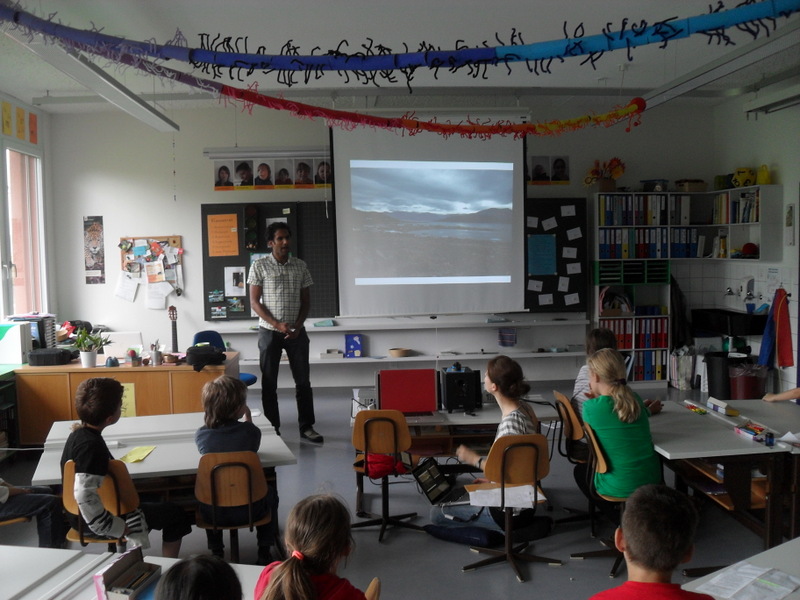
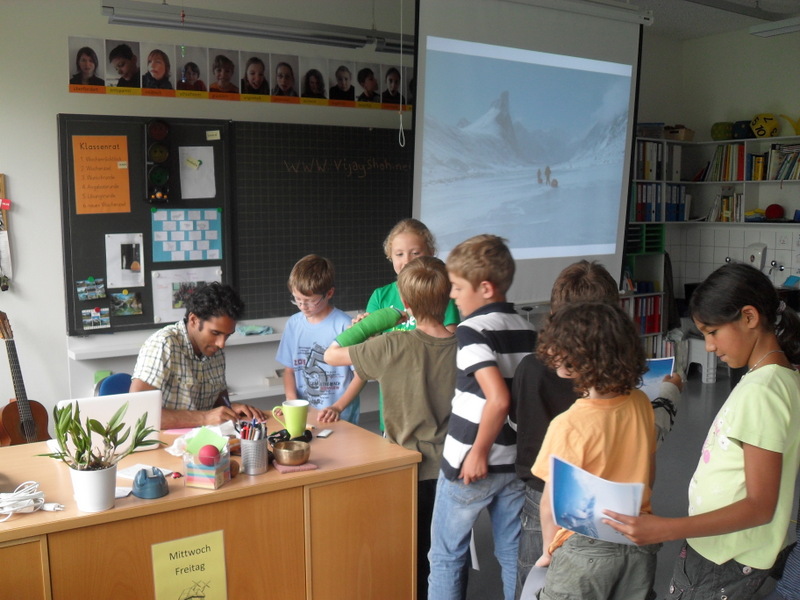
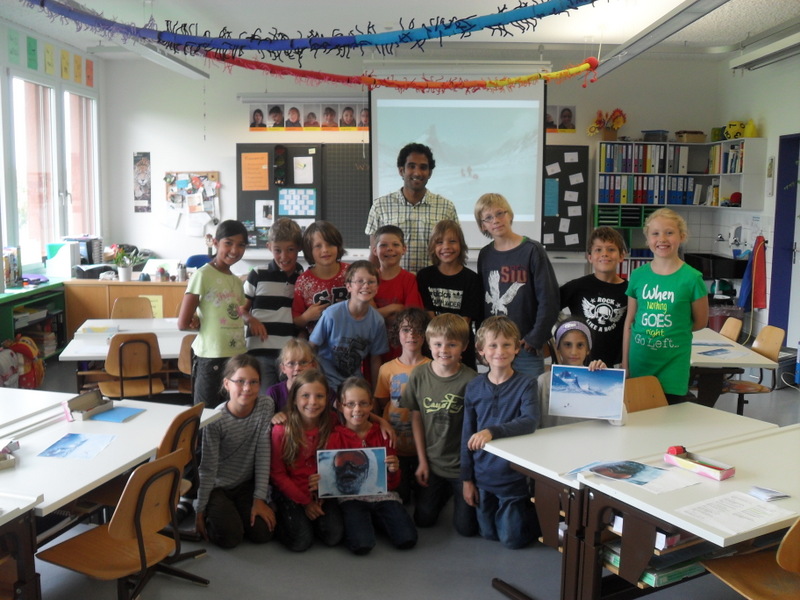
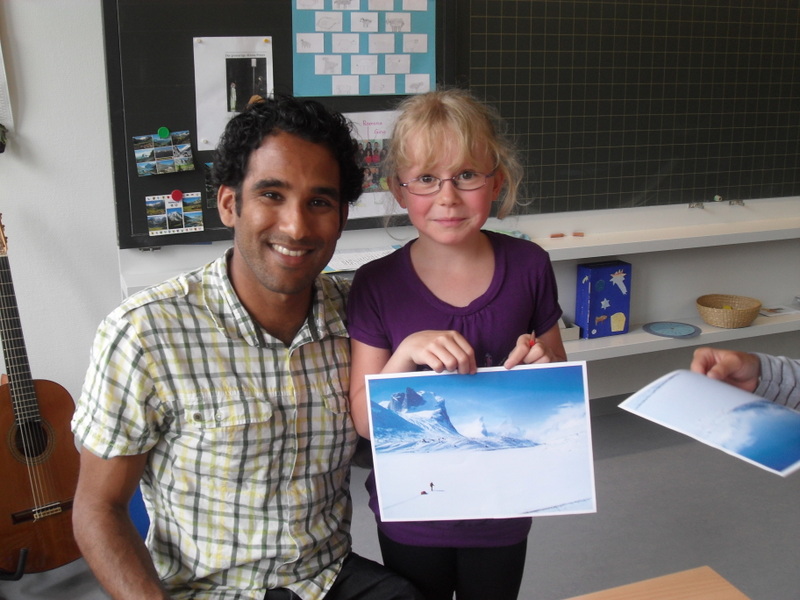
Les petits renards de Rodemack
As we sat the chill of a Spring evening crept over us. Coinciding with the setting sun the bird song notched up in volume and variety, surrounding us with an orchestra. A woodpecker hammered away close by, Julie got a glimpse but I didn't; the small bird was well hidden amongst the foliage of newly green trees. An owl hooted far off, distinct and precise amongst the background of song. We waited, yet the fox puppies did not emerge from their den. 'It's too late' Julie whispered. 'The best time is mid-afternoon'. I had a little more faith and preferred waiting - not least because I had made an hour detour through traffic stricken Metz to fetch my camera.
Then, after twenty minutes, a small movement by the den hole that we had so adamantly been watching. It was a small brown head that popped out of the den hole, a tiny fur ball perfectly camouflaged against the dirt walls. Not long afterwards another head came out from the blackness and another and soon enough a litter of five puppies were out trying to see and smell us with their underdeveloped senses. The smallest found a small leaf to play with but never strayed more than a metre from the den hole, the others stayed in the entrance trying to work out what all the fuss was about. The snapping of my camera shutter was an alien sound to them which kept them curious for about five minutes before finally they retreated back into the warmth and safety of their den.
A magical encounter!
Rodemack, Lorraine, North Eastern France.
VIDEO: Penny Ice Cap Movie (2)
Our Journey's Nick Peres has kindly edited our expedition footage creating a beautiful video. It gives a different pace to my video showing another face to the complex nature of the expedition and both videos compliment each other.
VIDEO: BAFFIN ISLAND 2011
It's taken some time, but finally I have finished the expedition video. As opposed to the other videos I have posted this one covers the expedition in it's entirety and hopefully will give you some idea of the different problems we faced as well as the amazing scenery. Please also see some of the articles I have posted on the expedition which provide more information and emotion to some of the more profound moments.
VIDEO: The Polar Bear Story
When it comes to Arctic wildlife - one thinks of the polar bear. A truly formidable creature: up to 3m tall when standing upright, weighing up to 700kg whilst being able to sprint up to 25mph. You may have already read about what happened when we came across a mother and two cubs as we made our way to the start point of our expedition.Here's the video:
A short film showing the start of our Penny Ice Cap crossing in Spring 2011. To get out to our start point we travel by snow mobile over sea ice for about eight hours. During which we came across some local wildlife...
BAFFIN ISLAND 2011: EXTREME CAMPING
Everything is about survival whilst living at -25C. Setting up and packing up camp is both a skill and an art to get right. We dance around the obstacles of time and weather, tiredness and grogginess to put the show on the road.
SETTING UP CAMP
After a full days skiing, our bodies are getting tired. The sun is beginning to set and the temperature will soon plummet. Setting up camp requires everyone to work efficiently and quickly.
PACKING UP CAMP
At -25C everything is important including packing up camp in the morning before moving onwards.
A -25C Wash
The last day of the expedition had arrived. I couldn’t believe it had come. Two weeks previously, with all the uncertainties and potential dangers ahead, I would have traded places with this day in a blink of an eye – now I would gladly have gone back two weeks.
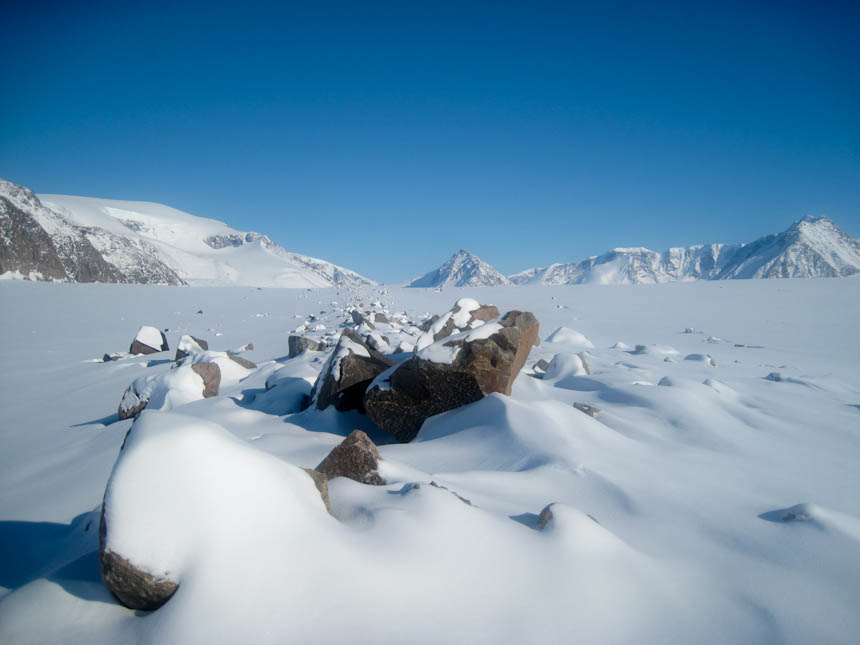
But still there was a large part of me that was glad that it was almost over. It was hard not to relax and to keep our guard up. ‘It’s not over until it’s over’ is what we had to tell ourselves, and as we woke up that morning we realised that the Arctic wasn’t going to let us go so easily. Blizzard – whiteout conditions. We were only 10km from Pangnirtung, the Inuit community that would be our last stop, and yet in a whiteout even 1km can become impossible. Visibility was down to only a few metres, we were in prime polar bear territory and we were heading to the floe edge – open water.
We had indeed crossed the Penny Ice Cap, making the first British crossing and opening up a new access route onto the ice cap itself. We had had difficult terrain getting onto the ice cap – climbing and traversing 30-40 degree slopes whilst dragging heavy equipment behind us. Such terrain we did not take lightly and opted for caching kit and going back two, three and sometimes even four times to keep the loads (and the danger) down. We had high winds on the ice cap – forcing us to construct shoulder-high walls each night to take shelter behind. At one point we were bent double fighting against a head-on wind that gusted at over 70km/h. Finally we had lived for 17 days and nights in temperatures never warmer than -10C and often below -20C, travelling over 250km, and climbing and descending 2000m well away from any human contact.
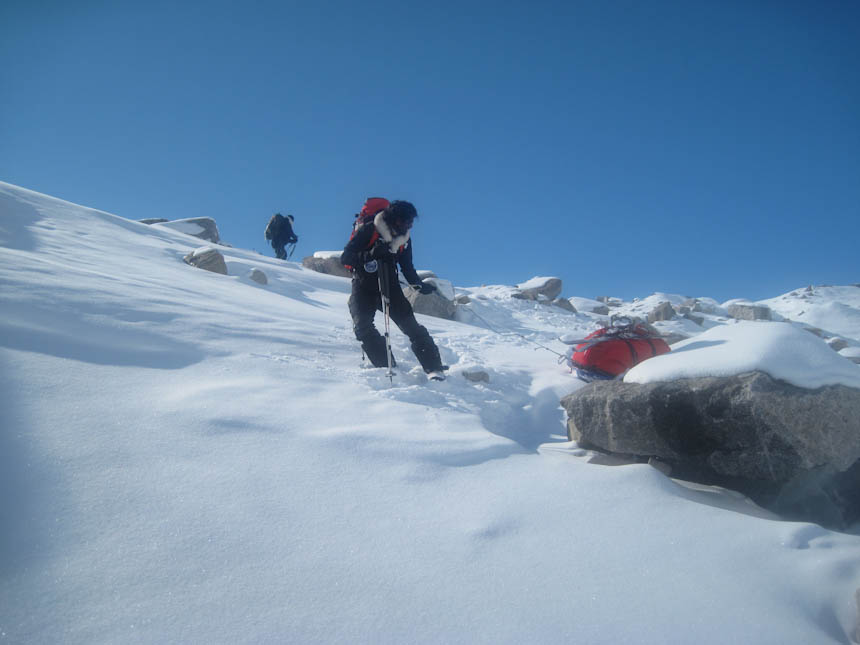
After all this, and only 10km from the end, it was thus hard not to be complacent. We ate breakfast and packed our pulks for the last time, and moved off into the white. We used the GPS as a backtracking tool to check our progress. The straight line between the front, middle and rear person is meant to help show whether a straight line is followed, but the whiteout disorientates and confuses. Often our progress was as much as 90 degrees out of our intended direction, and with the wind and snow to contend with our meandering progress was slow. But it was only 10km – no problem, right?
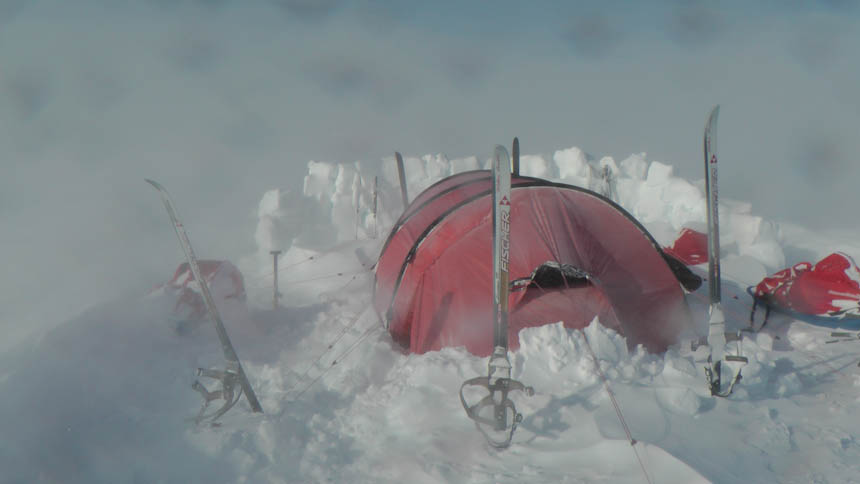
6km from the Inuit community we came to an area that the snow was a bit wet. I was ahead, so I tested the ground first, by stabbing hard with my poles before stamping down with a ski whilst supporting my weight on a safe area. It was a bit wet but felt solid enough. We could not see too far in front, or indeed the valley sides, thus had little idea of our position. It was not clear whether this area was local or extended – we had no reference. I moved tentatively onto the ice which held my weight well, so I continued slowly onwards, testing out the ice all the while.
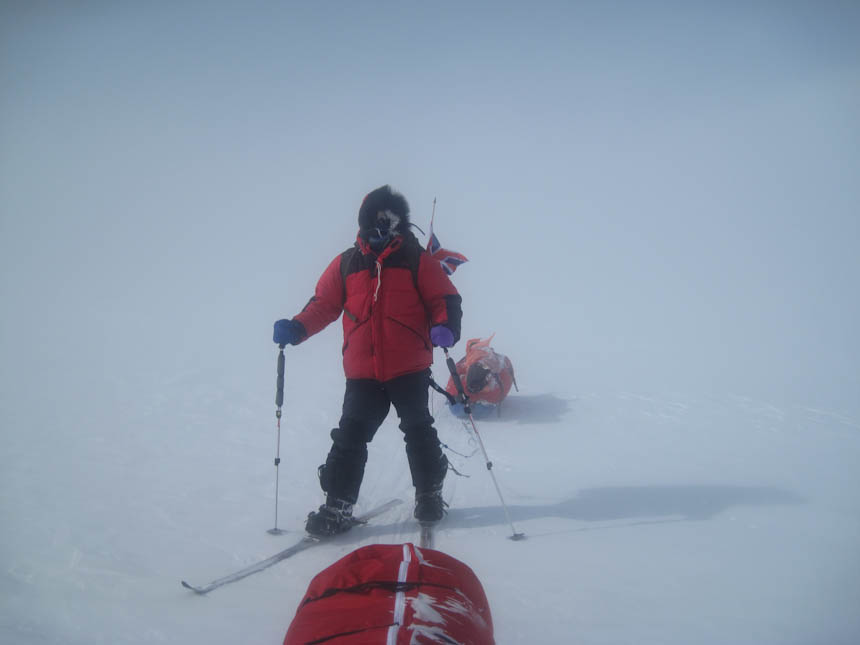
I had not advanced more than 50 metres before I heard shouting behind me. I whipped around to see Antony, seemingly okay. ‘Wait! Where’s Duncan?’ Twisting myself to look down, I saw a broken section of ice and Duncan in the middle of an opening. My tracks had weakened the thin ice and his extra weight had cracked it, dropping him, skis and all, into the freezing waters beneath. His pulk fortunately was still on the ice, far enough behind him to not fall through and drag him under, and the opening not large enough to take his arms, which were extended further by ski poles, holding his upper body out of water.
My initial reaction was to go back to help. Antony, however, having had previous experience with thin ice through training courses and his recent North Pole expedition, quickly took charge and stopped me from approaching, shouting “STAY STILL!” Which was obvious when thinking rationally, as the weight of another person over the thin and weak ice could have further increased the opening, or even led to that person falling in, worsening the situation considerably. The best solution was if Duncan could drag himself out of the hole and onto the surrounding ice. Time was of the essence as it would only take a couple of minutes before he became too cold to help himself. We watched as he used his arms and poles on the ice, clawing to gain purchase and started to drag himself out. He was heavily burdened by his skis and heavy water laden clothing making the task even more difficult. The opening opened further as he pushed against the edge. Rallying himself further he pushed through to the newly formed edge. This time it held and he was finally on his hands and knees, next to the hole. Even though he was out of the water and the immediate danger had been averted we were still on perilous ground. How weak was this area? How far did it stretch? And meanwhile Duncan was becoming colder and colder. The wind buffeted us, whipping the heat from his soaking wet clothing.
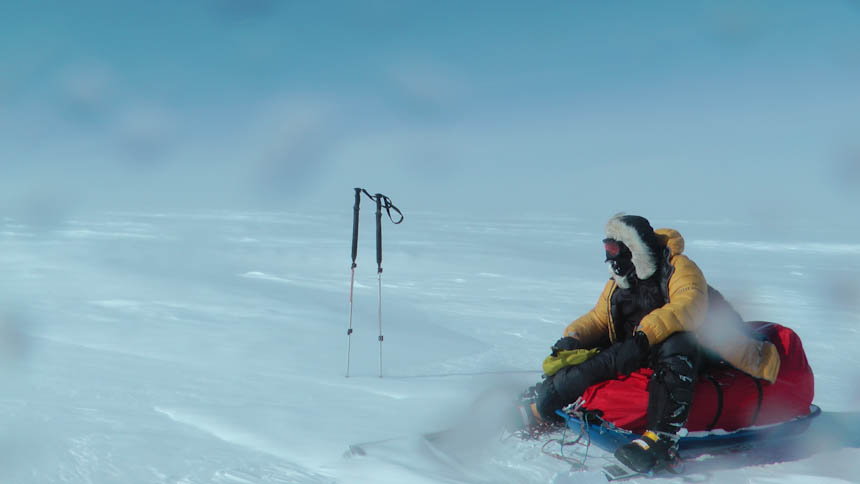
We moved off quickly, no longer following each other’s traces, each of us on a separate line in order to travel over ice that had not been weakened. We stabbed each point with our ski poles to check the solidity of the ice. At one point I felt my left ski punch through. I reacted quickly, switching my weight onto my poles and right foot, so only my left foot dipped into the water, fortunately well below the waterproof line. I took it out and sidestepped onto safer ground. We continued apace for about 10 minutes until we were sure we were on safer, thicker ice, then stopped to evaluate the situation. I looked down and was astonished to see the water that had remained on my boot had frozen up and collected a large amount of snow from the spindrift, in complete contrast to my black dry right boot. Duncan reported that the whole of his lower body was wet. His boots were filled with water, and his lower upper body was also soaked. This was dangerous – the cold water alone was problematic enough, but having wet clothing was even more so, as when wet, it becomes very inefficient at insulating. He was getting cold.
After such an event, the human body immediately releases adrenaline, allowing the body to cope with exceptional circumstances. Duncan’s body at this stage would have been pumping adrenalin, providing him with more energy and faster reactions. This adrenalin rush does not last long however, and is often followed by fatigue. Mentally though everyone acts differently. Keeping his morale up was essential to ensure he used what reserves his body had to cope with the situation. That was our job.
We joked with him about the incident, jokingly becoming upset that he had managed to have a wash whilst we both were still smelly in three-week-old clothing. We pushed onwards, increasing our speed in order to force Duncan’s body to keep generating the heat that would keep him warm. This strategy is normally only possible for a couple of hours, while the adrenalin was still in his body, giving him the energy to keep going. After this we would need to stop and probably make camp in order for him to get out of his cold, wet clothing and warm up in the tent. Fortunately for us we were only a few hours from the community, allowing us to make ‘somewhere warm and inside’ our direct aim and indeed an objective to keep Duncan focussed on. He was in good spirits, complaining little and moving well with the new pace we set through the blizzard. Antony was in front and I stayed behind as we pushed on, again involuntarily meandering through the whiteout.
Another hour passed. We continued on, knowing from the GPS that we were not far away but with no visual reference. “Getting cold now” said Duncan cheerfully as I again complained that he’d managed to wash and that I was so desperately dirty. From his relative lack of complaints, I took note that Duncan was probably getting very cold and pushed him further to catch up with Antony, who was now further in front. We were getting tired, having had no rest in the last few hours. But we knew we must be close, and we were traveling fast, in the right(ish) direction. Finally, a slight parting of the clouds, and we saw the unmistakable dark silhouettes of buildings directly to our left. Pangnirtung.
It still took about 30 minutes of frenzied skiing to find the frozen harbour and haul ourselves into the main town. The end in sight gave us new energy but Duncan fell a few times now, tripping up on the steep ground – the cold undeniably affecting his concentration. We parked our sledges by the national park office and made a beeline for the local cafe. Water flooded out of Duncan’s boots as he yanked them off, his socks dripping. The coffee and chips arrived soon after, steaming hot. A bite and a slurp later, a huge grin appeared on Duncan’s face. “We’ve done it!”
The Polar Bear Story
“You touched a baby polar bear?!??” is the first question that I’m asked now. This is followed straight away by “didn’t the mother take offense to that?” And by ‘take offense’ they mean that “didn’t mother polar bear swipe her massive paws with blades for claws at you and gouge out your insides?” and so I describe a situation that is both sad and cute, irresponsible and corrective but above all else amazing.

This was my third time in Baffin Island and I had not as yet seen a polar bear. I really wanted to see one. Safely, and from a distance, as all visitors to the Arctic wish. The Inuit too still get excited every time they see a nanok (polar bear in Inuktitut). So there we were at the start of our polar expedition attempting the first British traverse of the Penny Ice Cap, a distance of over 250km, rising from sea level to 2000m and back down again through temperatures below -25C and with winds of upto 70km/h. But first of all we had to get to our starting position.
Our starting point was actually some way away from the nearest Inuit community that we could get conventional transport to. That was because the communities are traditionally by the sea (or what is the sea once all the ice melts in the summer) and sea and Arctic coastal regions are stalking grounds for the polar bear. After not eating much for several winter months polar bears are quite hungry – not an ideal situation for us, as unprotected humans, to be in. Thus we started as far inland as we could, arriving there safely by having our Inuit outfitters drop us there by skidoo (snow mobile), a journey of about 8 hours. We had two skidoos, to manage not only taking the three of us and all our equipment, but also to give the Inuit drivers, Billy and Charlie, some equipment redundancy if one of the skidoos failed– crucial given that they could be potentially 8 hours away from their homes and shelter.
We started in the morning of a beautiful sunny still day, the temperature a balmy -15C and we were looking forward to an easy ride out to our start point.

We traveled past massive icebergs, halted in their voyage south by the freezing seas. They towered storeys above us, dwarfing us in their majesty. We stopped in awe and the silence that followed was deafening. We passed seal holes, where, some way in the distance, a seal was sun bathing. Arctic hares raced past us, somehow managing to maintain the same speed whilst shooting up a 50 degree mountain snow slope. We saw the extraordinarily shapes created by pressure ice as the sea froze, forcing us to weave in and out, up and down, to find the easiest way through. Then we came across the tracks of a mother polar bear and two cubs. The tracks were fresh. I remember putting my hand inside the paw print of the mother polar bear and gulping a little uncomfortably as my hand was swallowed up. We followed the tracks and came across a seal den, where seal babies are nursed. We could see where the polar bears had waited patiently, hoping to catch a seal, and their tracks further away into the distance when they had given up.

We continued on our way to our starting position but after a further hour, Charlie shouted “NANOK!” over the roar of the engine, whilst pointing to something in the distance. My eyes followed his finger to see, in the distance, only one white speck amongst many others, against a white snow background…I could not see the polar bear. I was driving at the time and he told me to stop. We quickly changed seats and he accelerated off. As we drew closer I suddenly made out the unmistakable form of the polar bear. Her fur had a yellow tint to it, making her stand out against the white background. She had two cubs with her, undoubtedly from this year’s litter, and still very young. They trundled along beside her, playfully tumbling in and out of her tracks. We moved closer still to get a better view and pictures. Too close!

Mother bear became startled by these two large, noisy machines hurtling towards her and in her fright took off away from us with her cubs following close behind. Her gait was quite comical to view from behind but her speed was incredible. We followed but in our excitement to see these wonderful creatures nevertheless scared her. She increased her speed further, but one of her cubs could not keep up. He slowly fell further and further behind and then he panicked. He stopped, turned and started running in a different direction, at almost 90 degrees to his mother’s tracks. The mother did not look back and was getting further away. We sped up, and tried to use the snowmobiles as a guide to force him back in the right direction. Our large unmaneuverable machines were insufficient to scare the small and agile bear in the right direction, but fortunately, eventually he crossed his mother’s tracks and started to follow them. We stopped and watched.

The baby bear was about the size of a midsize dog. In contrast to his mother his coat was a pure fluffy white, unblemished by life. He was probably only a few months old, born during the winter that had just passed. Female polar bears generally give birth to two or three bears per litter and twins are common. A pregnant bear creates a den inside the snow for the winter in order to rest and nurse her young. It is likely that they had only just emerged from their den and it was the young bears’ first few days in the outside world.

Barking continuously, the baby bear followed his mother’s tracks. But slowly and inconsistently. At one point he stopped and headed back towards us. His mother meanwhile had not slowed down and was well out of sight. After half an hour we were not sure whether he would find his way back to his mother, and he was too young to survive by himself. Billy, our Inuit outfitter explained “He is too young. He does not know what he is doing.” Billy decided then that the best course of action was to catch him and take him back to his mother on the snowmobiles. Seeing what distress we had caused and having already attempted to let the situation resolve itself, it was the only course of action left and one that we all accepted. The chase began.

We used the two snowmobiles to create a pincer movement. We came in from behind, overtaking the baby bear from the left and right before suddenly closing in, closing the pincer. Seeing his path cut off by the snowmobiles he stopped, barking ferociously, much like baby Simba’s roar in Disney’s Lion King, with his hot breath steaming out of his mouth. With him unsure what to do, we had time to try and grab him. Charlie jumped off the skidoo and grabbed his body. “Great!” we all exclaimed, and hoped for a quick end to this situation. But Charlie didn’t know what to do next, and nor did we. If he tried to pick him up he would be subjected to those great claws and those big teeth – scarily large even though he was so small. Thus we lost the element of surprise, and when the bear realised what was happening he started struggling. Just one movement of his head made Charlie back off, in fear of being bitten. Realising he was free the bear jumped over the overlapped snowmobile tracks that had closed him in and ran off. Charlie gave a futile and comical attempt to chase him on foot – no chance.

I jumped onto the driver’s seat to catch up with Charlie, whilst Billy took control of the other snowmobile and we caught up with the bear to try again. And again. And again. Each time the bear escaped, becoming more confident and bold in his attempts to escape capture – he was certainly outwitting us. We were going to have to immobilise and blindfold him so that he could not see where to attack. Billie was travelling with a spare tent that served as an emergency shelter if their snowmobiles broke down away far from their community, and we decided to use this sheet to capture the bear. Once again, Billie and I in control of the snowmobiles executed, what now became a perfect pincer movement. Charlie jumped out of the back of the snowmobile with the tent sheet and threw it over the bear. This allowed us to scoop him up without him fighting so much and place him in the sled at the back of the snowmobile. Charlie climbed in afterwards holding him down under the tent sheet. His barks became muffled. I jumped back again onto the driving seat and we pushed the two snowmobiles to their limits to try and find the mother. The terrain was fairly flat, but with small undulations created by the sea ice, making the ride at full speed quite bumpy. I looked back at my precious load continuously afraid that the bumpy ride will hurt our bear or enable him to escape. Even though the mother bear was well out of sight following her was quite easy once we had located her tracks. She had travelled a fair distance, covering over 10km in the hour or so since we had last seen her.
As we approached, the mother heard the machines, and started sprinting away at full speed. We swapped snowmobiles so that Billie could bring the snowmobile with the baby bear closer. I watched as they approached to within a few hundred metres of the mother, and quickly tried to release the baby bear. He got caught up in the guide ropes and there was a tense moment as we watched the mother disappearing away and the baby bear unable to disentangle himself whilst being within easy biting distance of Charlie and Billie. After a frantic pulling of the guide ropes he became free and quickly ran away – in the wrong direction. Billy chased him trying to force him in the right direction. But two human legs once again failed against four bear legs and he could not keep up. We could only watch. After running away in a panic he saw his mother who was now half way up a valley edge about 2km away and followed. He moved towards her, his barks becoming fainter with the distance he got away from us. Though we were a few kilometers from the mother we decided to move further back to allow her to relax. Turning back to watch from a safe distance we saw the mother stop and hearing her cub’s cries waited at her vantage point up the valley wall. The baby bear, with his cute shuffle, caught up with his sibling and together they climbed the hill after their mother. We turned away as we saw the three of them crossing the slope together, the mother walking in front, and the two cubs not far behind.
It was a happy reunion and one which we sheepishly celebrated. It was a situation that we had created and one that would not have occurred had our desire to see these fantastic creatures been satisfied by seeing them from a distance. We, as individuals and as a species, have a responsibility to wildlife and must recognise the effects of our actions. Even though I was thoroughly thrilled to have been so close to a wild polar bear I was sorry that this situation had emerged, and I hope that there were no long-lasting negative repercussions of the baby bear’s proximity to us humans.
Penny Ice Cap Press Release
PENNY ICE CAP EXPEDITION – PRESS RELEASE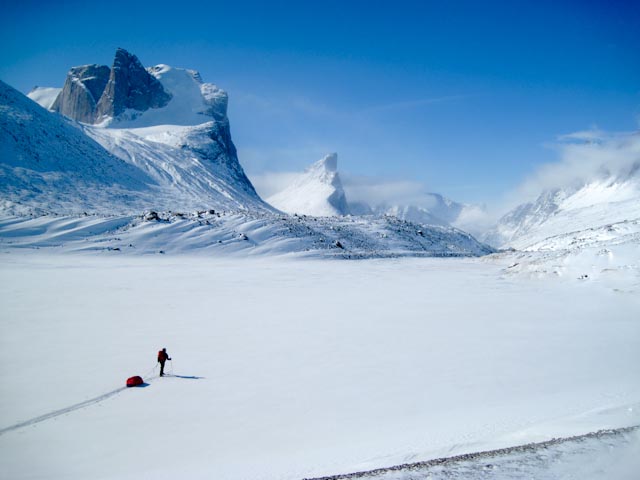 On Wednesday 11th May, Vijay Shah with team mates Antony Jinman and Duncan Eadie returned to the UK following a polar expedition on Baffin Island. They have become the first British team to ski unassisted across the remote Penny Ice Cap and have explored a new access route.
On Wednesday 11th May, Vijay Shah with team mates Antony Jinman and Duncan Eadie returned to the UK following a polar expedition on Baffin Island. They have become the first British team to ski unassisted across the remote Penny Ice Cap and have explored a new access route.
The project covered over 250km on skis, starting and ending at sea level but rising to 1940 metres at its highest point. Throughout the 18 day expedition, the team endured air temperatures of below - 25°C, blizzards and 70kmph winds. At times, this challenging arctic environment also meant the team had to ski and drag their 50kg pulks over extremely thin ice, the dangers of which are highlighted when Duncan fell straight through into the ocean on the way to Pangnirtung (Inuit Community), their final destination. Vijay said “Once Duncan had dragged himself out of the ocean, the team needs to keep moving and move quickly to stop him from freezing.” Skiing over new terrain also offered it’s challenges, “We never knew what was around the corner, or even if there was a corner!” Self-doubt also played its part and asked its own questions: “Did we have enough food? What if the weather closes in on difficult terrain?” This self-questioning is justified as at times the team were probably over 100km from any other person.
However, this extreme environment also offers spectacular rewards; the mountain passes made for extraordinary scenery as the team traversed this landscape documenting the changes taking place due to climate change, in photography and film. The team were also lucky enough to see some of the Arctic’s most documented wildlife in their natural habitat, including Polar Bears and cubs, Arctic Hare, Ptarmigans and Seals.
Schools have been tracking their progress via the Education Through Expeditions website (www.etelive.org), where teachers and students have been posting questions on the online discussion boards to learn about the Arctic, the Inuit people and the effects of climate change. “Using our satellite phones we could even answer specific questions about the expedition from the school children directly.” Vijay said. “Overall we worked incredibly well in our team – absolutely essential for survival – in order to successfully complete the expedition.”
Links: http://www.etelive.org/baffin
Plymouth Herald
A newspaper article in the Plymouth Herald last week:
